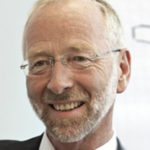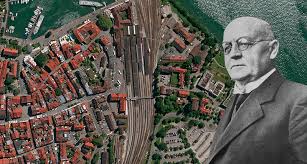Thanks to a kind invitation from Prof. Dr. Uwe Sörgel, I was able to attend the 57th Photogrammetric Week in Stuttgart, capital of Baden-Würtemberg, Germany. The history of this prestigious event has been provided to readers of LIDAR  Magazine in an earlier article. The 57th iteration attracted 280 participants from 50 countries. The day before the main event there was an afternoon tutorial, in which three well known academics (Dr. Michael Cramer, Dr. Gottfried Mandlburger, Prof. Norbert Haala) gave polished 90-minute lectures on “State-of-the-art in UAV-based mapping”, “Modern lidar sensor technologies”, and “Deep learning for remote sensing”. The 50 attendees were provided with rich fare and two themes emerged that would be repeated as the week went on. Cramer and Mandlburger reported a case study involving a precise UAV survey of a lock gate, where extremely high accuracy was sought, yet it was challenging to survey ground control points good enough for the task. Secondly, Haala’s lecture underlined the prevalence of deep learning for both imagery and point clouds – lots of people are benefiting, it seems to be superseding earlier technologies for classification, yet some users don’t quite understand it! In December 2019 there is a forthcoming workshop on Point Cloud Processing , which those deeply interested in the topic should try to attend.
Magazine in an earlier article. The 57th iteration attracted 280 participants from 50 countries. The day before the main event there was an afternoon tutorial, in which three well known academics (Dr. Michael Cramer, Dr. Gottfried Mandlburger, Prof. Norbert Haala) gave polished 90-minute lectures on “State-of-the-art in UAV-based mapping”, “Modern lidar sensor technologies”, and “Deep learning for remote sensing”. The 50 attendees were provided with rich fare and two themes emerged that would be repeated as the week went on. Cramer and Mandlburger reported a case study involving a precise UAV survey of a lock gate, where extremely high accuracy was sought, yet it was challenging to survey ground control points good enough for the task. Secondly, Haala’s lecture underlined the prevalence of deep learning for both imagery and point clouds – lots of people are benefiting, it seems to be superseding earlier technologies for classification, yet some users don’t quite understand it! In December 2019 there is a forthcoming workshop on Point Cloud Processing , which those deeply interested in the topic should try to attend.
The Photogrammetric Week is unusual in terms of attendees and format. Top academics mixed with government attendees and employees of system suppliers and service companies. Every morning there was a single track, with presentations from invited speakers on leading-edge topics. And in the afternoons from Monday to Thursday, the participants were divided into small groups to have demos from representatives of the PhoWo partners, Hexagon, IGI, nFrames, Pix4D, RIEGL, Trimble and Vexcel Imaging.
The Monday lectures were presentations by representatives of the PhoWo partners, describing what’s new in their products. There were several product announcements, such as the new lidar capability in version 4 of nFrames’ SURE software, version 9.2 of the Inpho suite, and the availability in the Leica CityMapper of the more powerful lidar from the Leica TerrainMapper. Emphasis by nFrames and Trimble on 3D meshes and true orthos underlines and the growing importance of these deliverables. IGI’s account of their role in integrating the sensor systems into Germany’s Open Skies aircraft, a converted Airbus 319, was very impressive indeed.
Tuesday’s lecturers on the conference’s first topic, “New sensors, positioning and navigation”, were a procession of big names: Uwe Rascher from ESA wth a keynote on the Earth Explorer 8 FLEX mission to measure solar-induced fluorescence; Michael Enseder from DLR on SAR imaging geodesy; Juha Hyyppä from the Finnish Geodetic Institute reporting their single-photon research; Ismael Colomina from GeoNumerics, Spain on the intriguing MapKITE, where a UAV follows a MMS van that has a control point painted on the roof to strengthen the geometry of corridor surveys; and Thomas Hobiger, University of Stuttgart, reviewing the challenges and risks in the navigation of autonomous vehicles. This superb morning ended with Dr. Hartmut Rosengarten of Leica Geosystems, part of Hexagon, deputizing for division president Jürgen Dold to present the Carl Pulfrich Award to Professor Bisheng Yang of Wuhan University for outstanding contribution in the field of point cloud processing. This was reported in full on our site and we’re already in correspondence with Prof. Yang about an article on his work. The remarkable scope and quality of the presentations continued on Wednesday, covering the second topic, “Autonomous driving, photogrammetry, mobile mapping”.

Uwe Franke
The keynote was Uwe Franke from Daimler, whom many of us remember from the 2013 Photogrammetric Week, describing work by Mercedes on vision systems for autonomous vehicles. He was followed by Christian Heipke (Leibniz Universität Hannover; President of ISPRS) on photogrammetric image sequence analysis; Philipp Lottes University of Bonn, on plant perception systems for agricultural robots; Fabio Remondo (Bruno Kessler Foundation, Trento, Italy) on geoprocessing of historical aerial images; Philipp Glira (Austrian Institute of Technology, Vienna) on combined adjustment of lidar point clouds and aerial images; and Davide Cucci on adjustment of raw IMU data and aerial images. The presentations by Colomina, Glira and Cucci were food for thought on approaches to optimal processing of sensor data.
Thursday’s topic was “Deep learning, crowd sourcing”. The three papers on the first part were given by Jan Dirk Wegner (ETH Zurich, keynote), Ribana Rocher (University of Bonn) and Peter Reinartz (DLR), whereas the crowd-sourcing speakers were Volker Walter (Stuttgart), Charles Toth (The Ohio State University) and Bernard Höfle (Heidelberg University). All six presentations were valuable updates in two key areas of today’s geospatial world.
The fourth and final topic, “Mapping, modern construction and visualization”, was more mixed. The keynote speaker was Nicolas Paparoditis (IGN, France; ISPRS Congress Director) on research trends and applications of 3D data at IGN; Willem van Hinsbergh (Kadaster, The Netherlands) on countrywide DSM and large-scale 3D production; and Christian Elsner (District Government of Cologne) on open data policy in Nordrhein-Westfalen. Thus we enjoyed three accounts of extensive efforts from national or regional mapping agencies. The final two talks, by Achim Menges and Daniel Weiskopf, University of Stuttgart, on integrative computational design and construction, and immersive analytics, were interesting but somewhat peripheral to the work of readers of this magazine.
The week of intense presentations from acknowledged experts, interspersed with the afternoon demos, was blended with a strong social program offering extensive networking opportunities, culminating in a cruise on the River Neckar on Thursday evening. This formula entices participants to return to Stuttgart. Your reporter has been doing so for almost 30 years and is pleased to conclude that this 57th Photogrammetric Week, the second under the leadership of Prof. Uwe Sörgel, was one of the best. Long may it continue.
A full article will appear in the digital and print versions of the magazine very soon, attempting to explore the significance of some of the messages from the speakers and PhoWo partners. LIDAR Magazine, furthermore, invited several symposiasts to submit articles! Meanwhile, mark your calendars for the 58th Photogrammetric Week, which will take place in Stuttgart from 13 to 17 September 2021! This event dependably serves top quality updates of the state-of-the-art in photogrammetry, lidar and remote sensing, all in a popular format honed over 110 years.
